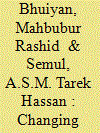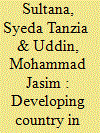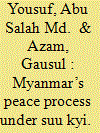|
|
|
Sort Order |
|
|
|
Items / Page
|
|
|
|
|
|
|
| Srl | Item |
| 1 |
ID:
167800


|
|
|
|
|
| Summary/Abstract |
The nature and means of conducting warfare have always been changing. Technology, political realities and ideologies continue to play crucial role in this transformation as witnessed in the two world wars, the Cold War, and in following decades. Non-state actors became more visible and important. Nowadays, many wars involve such actors against state parties, for example, the US global war on terror, Israel-Hezbollah War (2006) and the current war against the Islamic State (ISIL). The term hybrid war involves a combination of traditional and nonconventional means, has become a common subject of discussion. But hybrid war is nothing new and has been practiced since ancient times. Several countries have now resorted to hybrid war: one such country is Russia, who has been blamed by western countries in this regard, e.g., in Georgian War (2008), Crimea (2014), ongoing conflict in eastern and south Ukraine, disinformation campaign against the West and interference in their governance process. Russia similarly, blames them for its destabilization by increased military presence on its borders and inciting revolutions in neighbour countries. Meanwhile, countries are developing hybrid warfare capacities, including plans for deploying military robots. Non-state actors now also use hybrid means like the Hezbollah or ISIL and several ongoing wars are becoming growingly hybrid; besides, the clash of ideologies, i.e., religious radicalism vs. white supremacism can create conflicts, indicating future wars may be even more so. Yet, some old mechanisms and strategies are likely to remain relevant and useful in future wars as well, suggesting their true ever-evolving and hybrid character.
|
|
|
|
|
|
|
|
|
|
|
|
|
|
|
|
| 2 |
ID:
167803


|
|
|
|
|
| Summary/Abstract |
Global climate change is responsible for creating various types of security threats over the years. This incident also has posed major challenges to the natural resources aggravating socio-economic crises and triggering different level of inter-state and intra-state conflict. Various climatic hazards tend to induce migration both within a country and beyond national border which might exacerbate social instability and disorder among the international community, particularly in the conflict prone areas. The nexus between environmental change and resultant displacement remains one of the most debated and controversial issues of contemporary international affairs. Till date, the issue of involuntary or forced migration is yet to receive attention from the policymakers. Identification of the environmentally displaced people is a big challenge mainly because migration is a complex, and to a large extent, context-specific issue. However, without paying due attention, the miseries of environmentally displaced people will only aggravate. This paper is an endeavour to explore the scenario of environmentally displaced people in both of the contexts of contemporary international relations and mainstream refugee regime. With the same token, it also tries to assess whether any separate mechanism or special attention is needed to provide protection to the environment-induced refugees.
|
|
|
|
|
|
|
|
|
|
|
|
|
|
|
|
| 3 |
ID:
167801


|
|
|
|
|
| Summary/Abstract |
Dhaka is facing rapid unplanned urbanization with a huge population influx during the last couple of decade. In 1995, Rajdhani Unnayan Kartripakkha (RAJUK) prepared a 20-year plan for Dhaka city called Dhaka Metropolitan Development Plan (DMDP), a three tier plan including Structure Plan, Urban Area Plan and Detailed Area Plan. As the third and last tier, Detailed Area Plan was supposed to implement the provisions of the DMDP Structure Plan and Urban Area Plan policies and recommendations. The major focus of Detailed Area Plan was to put control over all development within RAJUK area through land use zoning and to lay down the framework for the development of future infrastructure and services. Although the first objective has been partially achieved, the second one has been ignored and violated. Powerful land developers and in some cases RAJUK itself has breached the land use zoning policy of Detailed Area Plan (DAP) and filled up the designated wetlands and flood flow zones which are mainly used as water retention zones. As a result, the drainage system of the city is facing obstruction and water congestion is becoming a very common chronic problem in Dhaka city. The water congestion situation of Dhaka city has reached a dangerous magnitude with the rapid unplanned urbanization. The present paper will try to focus on how the failure of Detailed Area Plan has impacted the water congestion scenario of Dhaka city which is increasing day by day as low lying water retention areas of the surrounding areas of Dhaka city are being filled up.
|
|
|
|
|
|
|
|
|
|
|
|
|
|
|
|
| 4 |
ID:
167804


|
|
|
|
|
| Summary/Abstract |
Since the end of World War II, Bretton Woods system remains in the midst of Global Economic Governance (GEG). International Monetary Fund (IMF) was created to regulate monetary policy, International Bank for Reconstruction and Development (IBRD), then World Bank (WB) was formed to look into financial aid and lending, and General Agreement on Tariffs and Trade (GATT), then World Trade Organization (WTO) was established to regulate trade. These institutions are yet to provide much space for effective participation of developing states and are dominated by developed world like United States (US), European Union (EU), etc. Hence, a vital target of Goal 16 of Sustainable Development Goals (SDGs) is to broaden and strengthen the participation of developing states in global governance institutions. Global financial crisis and economic rise of China and India have resulted in large-scale participation of developing states in global economic governance. Being a developing country, Bangladesh will be benefitted and able to broaden its participation from exercising practices of China and India in the institutions of global economic governance.
|
|
|
|
|
|
|
|
|
|
|
|
|
|
|
|
| 5 |
ID:
167802


|
|
|
|
|
| Summary/Abstract |
Before British occupation in Myanmar, the then Burma, the frontier areas of the country enjoyed autonomy under the dynastic rulers. The British colonials consolidated the country under a central rule. When anti-British movement started in Myanmar, the ethnic groups of frontier areas reclaimed their autonomy. The unanimous leader of Myanmar’s independence movement General Aung San desired an integrated Myanmar and reached in an agreement naming Panglong Agreement 1947, where all the stakeholders agreed to secure the identity and status of all ethnic communities and to develop a federal system where every community can get equal status. The assassination of General Aung San and subsequent military takeover of 1962 pushed the country towards a long-term ethnic conflict. The military rulers failed to accommodate demands of the ethnic communities and a policy of segregation undermined the nationality of ethnic groups. After seven decades, Aung San Suu Kyi’s arrival to power in 2015 raised new hope for reconciliation and the elected government of Myanmar started new peace process. But, the longstanding mistrust and conflict between the military and the ethnic groups are making the process difficult. Present study identifies the fault lines of new peace process and finds that the deficit of trust, the point of non-secession principle, disagreements on the incorporation of ethnic soldiers in the national military and debates on constitutional amendments are the main challenges towards a peace agreement between the government and ethnic communities of Myanmar.
|
|
|
|
|
|
|
|
|
|
|
|
|
|
|
|
|
|
|
|
|